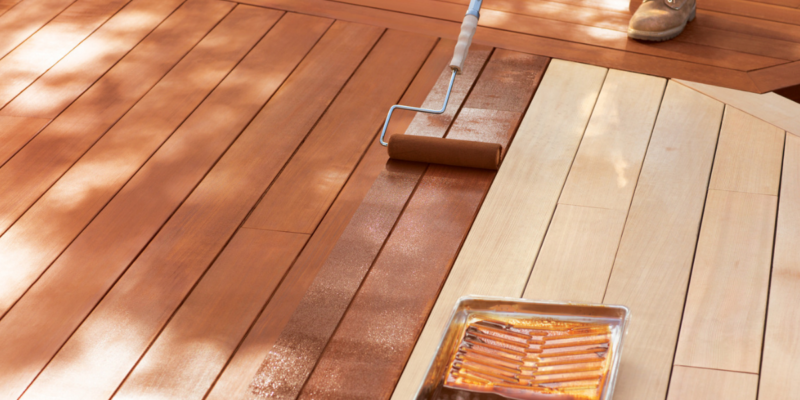CC’s Painting looks at the differences between the various types of stain so that you can get the look you want
Renew and Refinish With Stain
Changing of seasons marks a time to start some indoor and outdoor renovating. Whether it’s springtime when the warmer weather is approaching or autumn in time before the snow, either is great for getting a new stain done.
Refreshing the finish on decks, fences, and siding are all projects that top the to-do lists because, without renewed protection against Mother Nature, wood will start to decay. The sunlight breaks down the lignin that holds wood fibers together, leaving a gray surface that can’t hold a finish. Then water gets in, rotting boards and shingles and, worse, potentially compromising the structures that lie beneath them.
You can protect wood in one of two ways: either with paint, which seals it under an opaque film, or, perhaps better, with exterior stain.
The beauty of stain is that it’s easy to apply, resistant to peeling, and brings out wood’s texture or grain. But stain comes in a bewildering number of types. Some are as clear as bourbon; others are as milky as paint. Some form a film on top of the wood; others leave behind nothing but a hint of surface color.
Rather than waste time or money with trial and error in pursuit of the right stain for your job, take a look at the following types of stain we’ve put together for you.
4 Main Types of Stain
Semisolid
Has less pigment than a solid-color stain, so it only partially obscures the wood’s grain. Leaves no surface film; can’t peel. Recoat every 2 to 4 years.
Clear Toner
Finely ground iron pigments called trans-oxides block the sun without obscuring the wood’s grain and impart a warm tint. Leaves no surface film; can’t peel. Recoat annually.
Solid Color
Looks like a flat paint; hides the wood’s grain but not its texture. Forms a film that can peel if not properly applied. Recoat every 5 to 7 years.
Semitransparent
Contains enough pigment to change the wood’s color but not enough to obscure its grain. Leaves no surface film; can’t peel. Recoat every 2 to 3 years.
Which Stain Is Right For Your Home?
Before you buy, ask yourself these questions.
What’s the wood coated with now?
If it’s bare, chose whichever stain you want. But if it has a film finish, it’s easiest to stick with that; penetrating stains can’t go over a film. Also, water-based stains will cover oil-based ones, but not the other way around.
What kind of wood do you have?
Softwoods, like pine and cedar, easily accept any penetrating stain. But only certain kinds of seed oils, such as tung or linseed, will soak into ultradense hardwoods like ipe and mahogany. Always test these woods first to make sure the finish will penetrate and dry.
How worn is it?
On older decks, unless you can sand off the top layer you’ll get the best protection from a penetrating finish: a clear toner, a semitransparent, or a semisolid. Solid-color stains are best on new wood.
How much grain do you want to see?
The less pigment a stain has, the more grain you’ll see, as shown on the stack of blocks at left. But the more pigment, the longer you can go before recoating.
Where is it located?
Stain on horizontal or south-facing surfaces gets more punishing UV rays than on vertical surfaces or shady north sides. To minimize maintenance, consider stains with more pigment.
Additional Stain Options
Waterproofer Stains
Getting a waterproof stain is great for multi-season locations like the midwest, but still great to use in anyplace there is moisture. The waterproof option allows your stain to be a barrier and protector to keep moisture off the wood.
Eco-Safe Stains
Looking for a more environmentally friendly stain option? There are some out there and they are getting more and more popular. Be sure to tell us that this is something you are interested in if you are choosing us as your painter.
Multi-Color
Semitransparent and solid-color stains come in scores of hues, giving your home a painted look that’s a cinch to maintain. Follow along for a gallery of vibrantly stained, curb-appeal-boosting clapboards, shingles, and trim.
What’s Next?
Selecting the proper interior painting company for any home is key. CC’s Painting is here to help you take your idea to design to your dream home.
Call or Email us today for a FREE in-home consultation or FREE estimate!
Email us at: ccspainting@gmail.com
Call us at (262) 527-1822. We are waiting to help you!


I wanted to thank you for explaining different types of deck stains. I didn’t know that any softwood can easily accept any stain. It seems important to know what your deck is made out of if you can learn what category of stains you may need to get.
This is fantastic information! Thank you so much. Going look for stains with more pigment when I do my next job. Great advice, I enjoyed the reading.
Feel free to do interior painting and wood decking exterior.
Whether you’re sending something fragile in the mail or keeping valuables safe during a move, secure packing is everything.